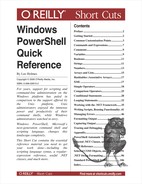<Pipeline> | <Formatting Command>
When objects reach the end of the output pipeline, PowerShell converts them to text to make them suitable for human consumption. PowerShell supports several options to help you control this formatting process:
All of the formatting defaults in PowerShell (e.g., when you do not specify a formatting command, or when you do not specify formatting properties) are driven by the *.Format.Ps1Xml files in the installation directory in a manner very similar to the type extension files mentioned in the “Custom type extension files” segment of the section “Working with the .NET Framework.”
To create your own formatting customizations, use these files as
a source of examples, but do not modify them directly. Instead, create
a new file and use the Update-FormatData cmdlet to load your
customizations. The following command loads
Format.custom.ps1xml from the same directory as
your profile:
$formatFile = join-path (split-path $profile) “Format.Custom.Ps1Xml"Update-FormatData –PrependPath $typesFile
